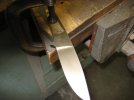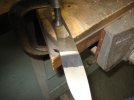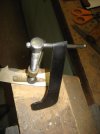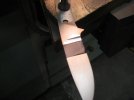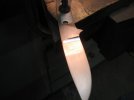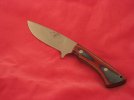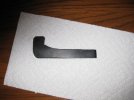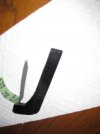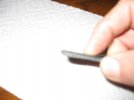- Joined
- Feb 24, 2000
- Messages
- 1,867
I have gotten a lot of good ideas and how to do it tips from this forum, so I thought I would try to give something back to it.
I don't recall reading a explination of how to hand sand the plunge line.
I prefer a satin finished blade over a mirror polish, so here is after 30 plus years of knifmaking how I do it.
This blade is ATS-34 and has been finished to 320 grit and heat treated by Paul Bos.
Here is what I do when I get the blade back.
First I put a piece of electritians tape around the blade back of the plunge line. See picture.
Then I take a 1/8" piece of micarta that I have a chisel grind on one end, wrap a piece of sand paper around the end and with a pushing, rocking motion clean up the plunge line.
The reason I use the electritians tape is to keep from wallowing out the area covered by the electrians tape.
After the plunge line is cleaned up, I remove the tape and use sanding blocks to finish the blade.
The sanding blocks are made from 2/4" lumber. I use a 10" contact wheel, so I trace the 10" wheel on a 2/4" and cut the shape out. I then cover the 2x4 with a piece of leather.
I use a paper cutter to cut sandpaper strips to fit the sanding block.
I know most use some type of fluid when they hand sand, but I don't. I like to see what I am sanding and for me the liquid gets in the way.
I don't recall reading a explination of how to hand sand the plunge line.
I prefer a satin finished blade over a mirror polish, so here is after 30 plus years of knifmaking how I do it.
This blade is ATS-34 and has been finished to 320 grit and heat treated by Paul Bos.
Here is what I do when I get the blade back.
First I put a piece of electritians tape around the blade back of the plunge line. See picture.
Then I take a 1/8" piece of micarta that I have a chisel grind on one end, wrap a piece of sand paper around the end and with a pushing, rocking motion clean up the plunge line.
The reason I use the electritians tape is to keep from wallowing out the area covered by the electrians tape.
After the plunge line is cleaned up, I remove the tape and use sanding blocks to finish the blade.
The sanding blocks are made from 2/4" lumber. I use a 10" contact wheel, so I trace the 10" wheel on a 2/4" and cut the shape out. I then cover the 2x4 with a piece of leather.
I use a paper cutter to cut sandpaper strips to fit the sanding block.
I know most use some type of fluid when they hand sand, but I don't. I like to see what I am sanding and for me the liquid gets in the way.

